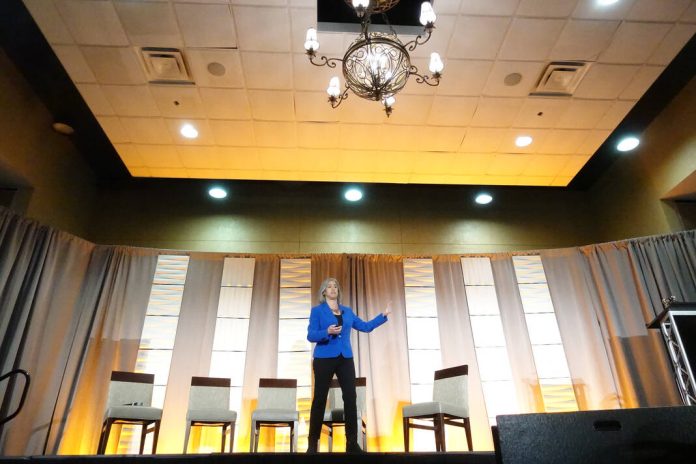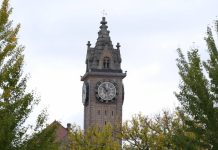
Keynote speaker Ilana Preuss makes comments during the State of the Region Conference Monday at the Hilton Garden Inn at Levis Commons in Perrysburg.
J.D. Pooley | Sentinel-Tribune
PERRYSBURG — Wood County is emerging as a leader in several state and regional economic indicators, as reported in the 2023 Bowling Green State University State of the Region.
The State of the Region Conference was held on Monday at the Hilton Garden Inn at Levis Commons. The several hundred attendees include elected officials, economic developers and business leaders.
VIDEO: BGSU holds 21st annual State of the Region Conference
The theme was “Building a resilient and equitable economy through investment in small business capacity” — a position that Wood County is already embracing.
“In 2021 The real gross domestic product of Ohio increased by 5.9%, compared to the previous year. This is the most growth the state has seen since 2011. That is significant,” said Interim BGSU Center for Regional Development Director Nichole Fifer, Ph.D. “This is a welcome rebound from the shrinkage that we saw in 2020, which was attributed to the COVID-19 pandemic.”
She added that the 2011 GDP increase was 3.3%.
Wood County was a top five regional leader in several economic indicators, but Lucas County showed larger gains in many recovery indicators since the lows of the COVID-19 pandemic.
Wood County did not place in the top five for gross regional product, but did show noteworthy improvement with a $1 billion, 95.98%, gain over the five-year period, reaching $3.695 billion GRP. Lucas County showed the greatest growth in the region, with an $8 billion increase, or 337.46% increase over the five year period.
From 2018 to 2022, Wood County was fourth in the state, and second in the northwest region, for net job gains, at 2,213, or 3.07%.
“Job growth in the state has been concentrated in the suburban areas, mainly around Columbus and Cincinnati,“ Fifer said.
Fifer broke down the statistics into three primary sectors: manufacturing, professional and transportation/warehousing.
Lucas County held the top spot for job gains in manufacturing for the northwest region, at 1,642; 6.68%. Wood County was fourth in professional, scientific and technical services category, at 149; 9.15%, and second for transportation and warehousing, at 1,990; 34.59%.
New business applications for Wood County from 2020-21 were at 944, or a 15.5%, placing it sixth in the region. Once again, Lucas County took the first spot with 6,566 application and 32.1% growth.
Fifer showed a CIFT agribusiness produced video of one of their small business success stories, Marsha’s Buckeyes, a local business started in Perrysburg.
After presentation of the economic and business data, keynote speaker Ilana Preuss spoke on bringing small scale manufacturers into local economic development plans.
Preuss is the founder and CEO of Recast City LLC and the author of “Recast Your City: How to Save Your Downtown with Small-Scale Manufacturing.”
She pointed out that after 1.1 million COVID-19 related deaths, there are “hard realities” to start from when attempting to improve the small business climate. In addition to the deaths, the businesses were closed for months and that 80% of all counties are seeing a decline in working age population.
One of the biggest hurdles for local municipalities is vacancies.
“A vacant building on the block can reduce the value of nearby properties by 20% or more,” Preuss said.
She recommended that local governments do four things: “invest in people who live there, invest in the place – with those people, create a new structure to support, scale, and invest in this and think long-term, but act now.”
One suggestion that she mentioned in several different ways was to have local municipalities meet with businesses, from their beginning. She also suggested that the municipalities modify zoning laws to encourage the small businesses.
The small business focus is already happening locally.
Bowling Green Mayor Mike Aspacher, in a follow-up interview to Preuss’ presentation, said he’s hoping to see physical improvements happen in the downtown, in ways to support small businesses.
“Late last year we initiated a really downtown centered focused visioning process,” Aspacher said. “We’re partnering with people at Bowling Green State University, at the Regional Growth Development Partnership, and we’re in the process of gathering feedback and data. So this is a very downtown centered project to determine what the next stage of development and improvement in downtown Bowling Green is going to look like.”
He also mentioned successes with local festivals, like the Firefly events and the Black Swamp Arts Festival, to support the small business.
“That brings a great number of creative people into Bowling Green. So, we have the opportunity to engage with some of these entrepreneurs and creative people, and perhaps discuss with them ways to create additional opportunity in the downtown,” Aspacher said.




